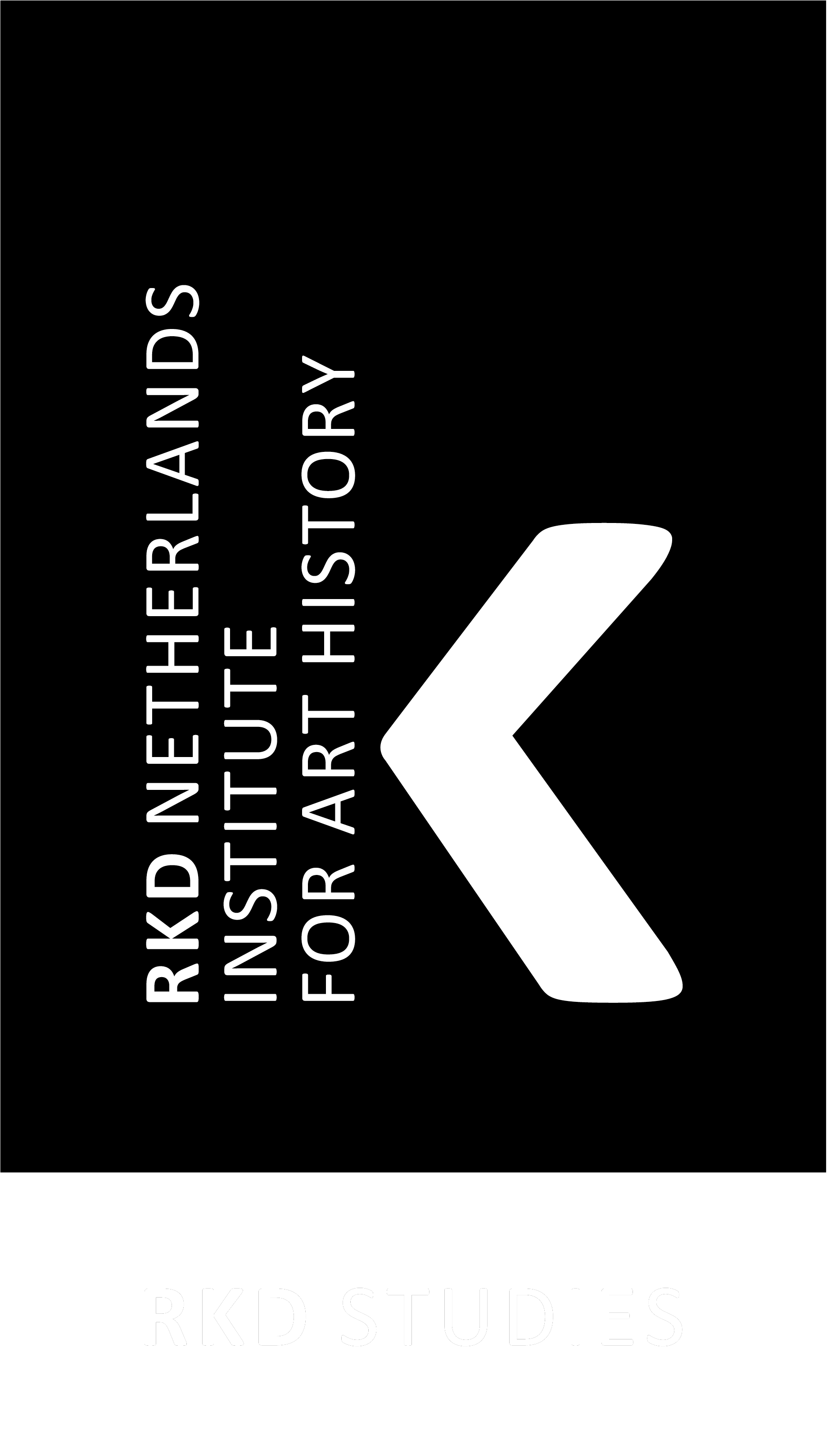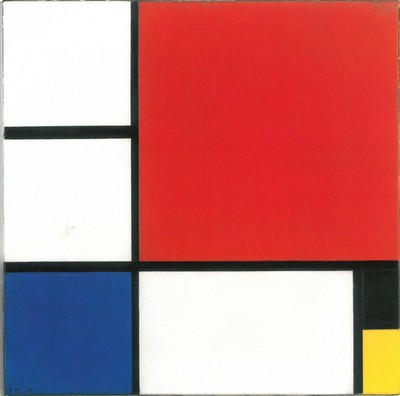Document acties
Notes to Readers
This publication includes basic art-historical information – title, date, technique, dimensions, signature, collection and oeuvre catalogue numbers – of all Piet Mondrian’s works of art in Welsh/Joosten 1998. 1 The corresponding record in RKDimages and the full information about the work are accessed by clicking on the illustration of the work and selecting ‘Show in RKD database’. This digital oeuvre catalogue is part of the Mondrian Edition Project, whose objective is to provide a complete scholarly digital publication of all Piet Mondrian’s letters and theoretical writings.
Classification
Welsh/Joosten 1998 assigns all works of art by Mondrian a catalogue number preceded by the letters A, B and C. In Volume I, which was compiled by Welsh, there are more than 700 works with an A number. These are naturalistic works created up to 1911. Joosten compiled Volumes II and III, which contain 415 works of art with B numbers (the abstracted and abstract works from 1911 until Mondrian’s death in 1944), and 155 C numbers (late naturalistic works created after 1910) respectively.
The presentation of the consecutive catalogue numbers has been retained for the digital oeuvre catalogue, but the precise classification differs in part from that made by Welsh and Joosten. As far as possible, Welsh classified Mondrian’s early oeuvre chronologically on the basis of the locations Mondrian painted, such as Winterswijk, Amsterdam and Twente, followed by a figure that refers to the number of times Mondrian returned to those places. In compiling the digital publication, it was necessary to restrict the number of illustrations shown on one page for the sake of clarity and readability. Most of the ‘chapters’ Welsh defined contained far more works of art than this maximum number. They have therefore been newly classified into smaller chapters based on the subjects, like figures, portraits, still lifes, landscapes and townscapes, which continually recur in this part of Mondrian’s oeuvre. 2 The sequential A numbers follow the titles of the chapters in the digital oeuvre catalogue.
Mondrian dated his later work, so Joosten was able to create a chronological sequence. Joosten’s classification, in which the paintings are presented by year, has also been maintained as far as possible in this digital catalogue. In a few cases, however, some of the 33 separate chapters in this second volume have been combined.
New Possibilities
Finding a specific work in Welsh and Joosten’s publication can be extremely difficult for anyone who does not know the catalogue number of a work and is not thoroughly familiar with Mondrian’s oeuvre. All Mondrian’s works have now been entered in the digital oeuvre catalogue and there are various ways of searching for the almost 1,500 works. 3 It is possible to select, for example, by exhibition, sale, provenance or technique (painting, watercolour, drawing etc.). The sort function makes it easy to group works of art. Collection catalogues can be put together by selecting one institution: for example, all 318 works by Mondrian in the Gemeentemuseum Den Haag. Search criteria can also be combined, for example a drawing of a mill from the period 1890-1900.
If a work’s oeuvre catalogue number is known, it is only necessary to click on the relevant chapter. It is also possible to search by oeuvre catalogue number.
This publication is also useful to anyone who just wants to get an impression of Mondrian’s oeuvre and is not looking for a specific work. It can be used to browse through Mondrian’s entire oeuvre.
RKDimages-records
Titles
Robert Welsh and Joop Joosten devised various systems for presenting research information in their publication. One related to the formatting of the titles of the works of art. In the paper oeuvre catalogue the significance of the titles is indicated by means of capital letters, inverted commas or italics. Welsh and Joosten gave precedence to the titles Mondrian himself gave his works. When known, these titles are printed in capital letters in their oeuvre catalogue. Titles shown between inverted commas come from letters, quotes from other people and exhibitions that may or may not be traced back to the artist. Finally, the titles Welsh and Joosten devised themselves or took from others are shown in italics. The primacy of Mondrian’s own titles is all that has been retained for the input in RKDimages. They are identified by the addition of ‘authentiek’, or ‘authentic’ in the case of an English title, in brackets. 4
Literature References
This digital version does not include all the information that Welsh and Joosten provided for each work. Literature references have generally not been adopted. This also applies to the observations made by both authors in the artwork entries, in which arguments for the determination of dates or exact locations are explained: reference is made to the paper publication. However earlier oeuvre catalogues, specifically Michel Seuphor’s Piet Mondrian : Life and Work [1956] and the revised second French edition of 1970, Maria Grazia Ottolenghi’s L’Opera Completa di Mondrian of 1974 and Piet Mondriaan. Een catalogus van zijn werk in Nederlands openbaar bezit by Cor Blok of 1974, are included because they are also presented in Welsh/Joosten 1998 separately from the other literature references.
Exhibitions and Provenance Information
All exhibitions and provenance information have been included, and in a number of cases exhibition references have been corrected. All sale information has been checked.
Information from Other Sources
In some cases factual information from other sources has been included if it differs from what is stated in Welsh/Joosten 1998. It may relate to provenances in sale catalogues published prior to 1994 and those seen by the authors but not followed. For completeness the provenance given by the auction house is included with a reference to the source. Because all the sales mentioned have been verified, it has been possible to add the sale prices and names of buyers (where known), to the digital oeuvre catalogue.
New Attributions
Following the publication of Welsh and Joosten’s oeuvre catalogue, there have been occasions when new works by Mondrian have come to light. These works are shown in this digital catalogue for the first time, presented in one place in the Additions chapter. There are attributions (from after 1994) by the Mondrian experts Joop Joosten, Robert Welsh, Hans Janssen (curator of Gemeentemuseum Den Haag) and Wietse Coppes (editor of the Mondrian Edition Project, RKD). The records Welsh and Joosten kept of them are in their archives, which are housed in the RKD. For more information about these works see Additions.
Information after 1994
Welsh and Joosten’s research ended in 1994. Because there have been dozens of exhibitions and publications since then, it was decided to include this new information in the digital catalogue, although completeness was not the objective. This supplement is primarily intended as an initial step in reducing the backlog and storing this kind of information in a central (digital) place now and in the future.
It was not always possible to establish from the publication accompanying an exhibition which works were actually in the show. In these cases there is no exhibition reference, but a literature reference in the relevant artwork records. All the newly added literature and exhibition references appear in the bibliography.
Provenances and current whereabouts have been brought up to date where possible. The sources consulted are the archives of Robert Welsh and Joop Joosten, the Artnet website and the websites of Christie’s, Sotheby’s and various other Dutch and international art dealers and museums.
Every effort has been made to include at least one colour illustration of all the works of art in the digital oeuvre catalogue. When this proved impossible, a black and white reproduction is available. In a few cases no illustration could be found.
Adjustments and additions are always welcome and can be passed on to the RKD on info@rkd.nl.
The technical description (techniques, materials, sizes etc.) of the works largely corresponds to that in Welsh/Joosten 1998. For their Readers’ Notes see pages 138-40 in Volume I and pages 186-97 in Volume II.
For the rationale underpinning the locations Welsh identified, reference is made to his introductory texts preceding each of the eleven chapters in Volume I, and to his remarks in the entries on the individual works of art.
Available in RKDexplore, by clicking on the illustration of the work and selecting ‘Show in RKD database’.
For completeness, the full title given in Welsh/Joosten 1998 can be found in the artwork record (under literature).


